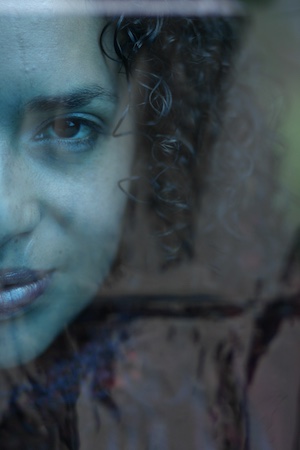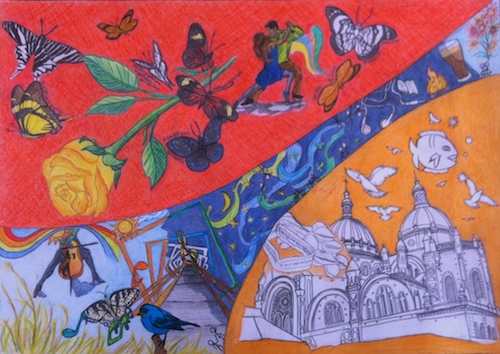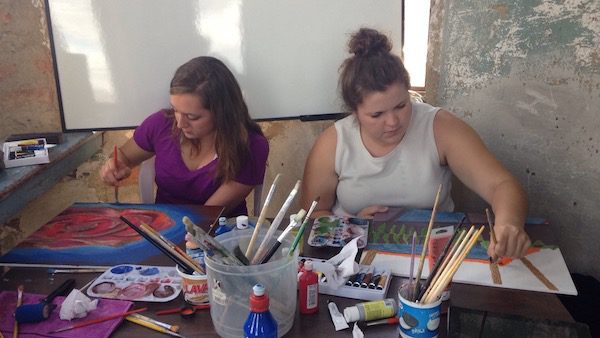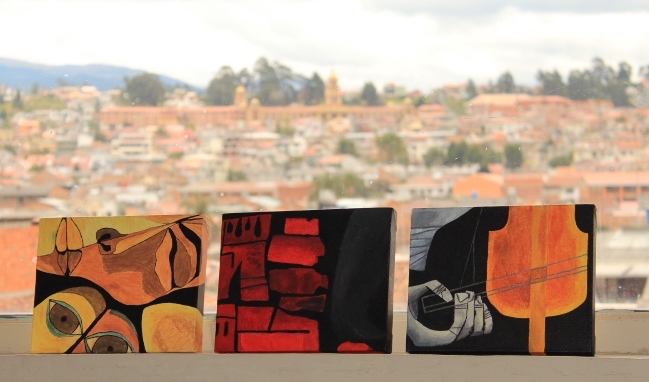Our Innate Creativity: Nuestro Creatividad Implícito
Our Innate Creativity: Nuestro Creatividad Implícito– An Interview with Jobita Anguisaca, Art Professor at CEDEI
“…because art is creativity and expression, which are innate in every human being.”
“…porque el arte es creatividad y expresión y eso va implícito en cada ser humano.”
Where are you from and how did you begin this work as an art professor?

Jobi Anguisaca
I was born in Cuenca and studied in la Escuela de Artes de la Universidad Estatal de Cuenca; I received my degree in Visual Arts. I started teaching painting during the year I was working on my thesis, in schools and high schools around the city. Later, I worked for the FoMN, which works with students of different capacities and abilities to promote are as a method of expression, as something both therapeutic and artistic. I loved working there, and I learned a lot from them. The purity of these students, their innocence, was something that really left a mark, as well as the expressions of color and creativity I witnessed there.
Later, I started work with CEDEI Foundation to teach Latin American Art and Painting (acrylic techniques) to students in the International Programs office. And that’s how I arrived here; it’s been a great opportunity to dive into the marvelous world of pre columbian artists, to reach into the manifestations of Latin American culture that are latent and present all around us. This, in turn, has allowed students to have authentic exchanges with the culture while broadening their perspectives; students share what they know from different parts of the world, enriching the class and teaching us along the way.
Where did you learn to be an artist?
Learning to be an artist is something that you are born with, and later, you receive guidance from family and school. Like every profession in life, it requires constant attention and dedication. I remember when I was very young, I would paint with watercolors every day, and I would give these drawings to my teacher the following day.
 To you, what does “art” mean?
To you, what does “art” mean?
Like I always tell my students, art is in everything and everyone, because art is creativity and expression and these things are implicit in every human being.
Who is an artist?
An artist is the person who manages to create an image, sound, or movement that the soul and the consciousness want to be understood.
Do you have any favorite artists? Who and why?
I have many favorite artists. For me, it’s easier to name artistic movements, because within these movements I find many artists whom I enjoy. I have a fascination for three epochs: Pre Columbian art,Renaissance art, and Impressionist art. In terms of modern artistic geniuses, Santiago Calatrava fascinates me, because his works transport me to a different world.
What is your typical class like? How do the students practice art?
My greatest hope is to motivate students to be curious.
 Latin American art, for example, is a combination of theory and practice. I aim that the lectures, images, and conversations are interwoven with our practical lessons, where we explore through clay, collage, museum visits, gallery visits, church visits, and interviews with artists and cultural managers. For Painting Class, for example, it is a class that mostly focuses on the practice, where students learn diverse techniques and themes that encourage each student to connect with the environment and personal experiences during his/her time in Ecuador.
Latin American art, for example, is a combination of theory and practice. I aim that the lectures, images, and conversations are interwoven with our practical lessons, where we explore through clay, collage, museum visits, gallery visits, church visits, and interviews with artists and cultural managers. For Painting Class, for example, it is a class that mostly focuses on the practice, where students learn diverse techniques and themes that encourage each student to connect with the environment and personal experiences during his/her time in Ecuador.
Why do you think that exchange programs, or study abroad programs, are important now?
The cultural exchange program opens doors to better understand each of us. We understand our differences, learn to respect our traditions and beliefs in one another. These programs make my world, and the world of another, find points of commonality. From that point of connection, the barriers disappear and the ties that bond us strengthen.
| Original Interview in Spanish:
De donde es y cómo empezar en la profesión de maestra del arte? Nací en Cuenca y estudié en la Escuela de Artes de la Universidad Estatal de Cuenca; obtuve mi título de licenciada en Artes Visuales. Empecé enseñando pintura durante mi año de tesis en escuelas y colegios de la ciudad y luego trabajé para la Fundación Mundo Nuevo, quienes acogen a estudiantes con capacidades diferentes y promueve el arte como un medio expresivo, terapéutico y artístico. Me encantó trabajar ahí y aprendí mucho de ellos, su pureza fue algo que me impactó y las riendas del color y la creatividad se hicieron presentes. Luego entré en la Fundación CEDEI, para enseñar Arte Latinoamericano y Painting (técnicas en acrílico) para estudiantes de Programas Internacionales. Esto es y ha sido una gran oportunidad para ahondar el maravilloso mundo artístico precolombino, hasta llegar a manifestaciones culturales latinoamericanas latentes a nuestro alrededor. Esto a su vez ha permitido intercambiar experiencias y perspectivas culturales con los estudiantes que nos han visitado de diferentes partes del mundo, enriqueciendo la clase y aprendiendo mucho de ellos. |
Donde aprendió ser artista?
Aprender a ser artista es algo con lo que se nace, y luego necesita ser apoyado (desde la familia y la escuela), y como cada profesión en la vida, necesita de mucha entrega y formación constante. Recuerdo que desde muy pequeña, pintaría acuarelas cada día y daría de regalo a mi profesora al día siguiente.
Para tí, que significa “arte”?
Como siempre digo a mis estudiantes, el Arte está en todo y en todos, porque el arte es creatividad y expresión y eso va implícito en cada ser humano.
Quién es artista?…
Quien logra poner en imagen, sonido o movimiento aquello que el alma y la conciencia logra comprender para sí.
Ud. tiene artistas favoritas? Quién y porqué? Tengo muchos artistas favoritos. Me es más fácil nombrar corrientes artísticas, porque dentro de ellas encuentro a muchos que me encantan. Tengo fascinación por tres épocas: Arte Precolombino, Arte Renacentista y Arte Impresionista. En cuanto a artistas-genios actuales me fascina Santiago Calatrava, porque sus obras me transportan a otro mundo.
Qué es una clase típica con usted- que hacen los estudiantes? Como lo aprenden? Mi mayor deseo es motivar al estudiante a ser curioso. Arte Latinoamericano, por ejemplo, es una combinación de teoría y práctica. Intento que las lecturas, las imágenes y los diálogos sean llevados a clases prácticas, a través de la arcilla, el collage,visitas a museos, galerías, iglesias y entrevistas a artistas y/o gestores culturales.
Para Painting es una clase mayormente práctica, donde aprenden diversas técnicas y los temas planteados los invita a conectarse con su entorno y experiencias personales de su visita a Ecuador.
Porque piensa que las programas intercambias son importantes ahora y en este mundo? El intercambio cultural abre las puertas para entendernos entre sí. Comprender nuestras diferencias, respetar las costumbres y creencias del otro, hace que mi mundo y el del otro encuentren un punto de encuentro mutuo. Desde ahí las barreras desaparecen y los lazos crecen.

